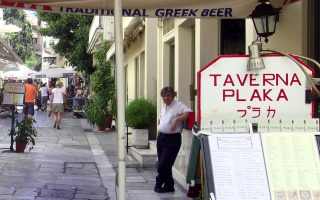New publication provides clearer picture of Greek islands

For most residents of mainland Greece, the islands are often endowed with somewhat mythical dimensions associated with summer holidays. But what are Greece’s islands really like, guide-book descriptions and stereotypes aside? The answers lie in a new atlas of the islands created by the University of the Aegean, an impressive piece of work that is interesting not just for the encyclopedic knowledge it imparts, but also the useful information on the character and evolutions of the islands, their potential and weaknesses.
The atlas is the work of the university’s Laboratory of Regional and Island Development and the team was headed by Assistant Professor Ioannis Spilanis from the Department of Environmental Studies and Thanassis Kizos from the Department of Geography. It covers all of the country’s 114 populated islands from a geographic, demographic and economic perspective, and includes some really fascinating information.
In the prefecture of Lasithi on Crete, for example, the primary sector represents the largest share of the local economy at 10.77 percent compared with the country average of 3.69 percent. Manufacturing is almost nonexistent on the islands, from just 1.42 percent of gross domestic product on Cephalonia to 6.05 percent in Iraklio, Crete. The presence of the civil sector is particularly high on the Aegean island of Lesvos, at 35.2 percent, followed by the prefectures of Iraklio and Hania on Crete.
Meanwhile, the largest number of businesses per 100 residents are to be found on Patmos (42.7), Paxi (29.3), Sifnos (26.5) and Ios (25.6). The smallest are on Nisyros (5), Oinousses (4.9), Psara (4.8) and Agathonisi (4.3), while the biggest surprise comes from Samothraki, which has the highest turnover per business, followed by popular holiday islands Myconos and Rhodes.
Employment
The five islands with the highest rate of employment are Koufonisia (49.6 percent), Myconos (48.7 percent), Kos (46 percent) and Irakleia (45 percent). In contrast, the highest rates of unemployment are on Mathraki (61 percent), Antikythera (50 percent), Othonoi (27 pct) and Nisyros (25 percent).
In terms of tourism, the University of the Aegean found that the majority of beds is concentrated on a limited number of islands: Crete has 164,249, Rhodes 84,942, Kos 45,097, Corfu 43,940 and Zakynthos 28,837, while these are followed by Evia, Santorini, Myconos, Thasos and Cephalonia, which all have more than 10,000 beds. At the other end of the scale, Greece has 12 islands with less than 100 hotel beds and another 12 with no hotels at all.
However, the rise in the number of hotels beds has been most rapid for those islands that experienced a boom in tourism in the 2000s, such as Koufonisia, Meganisi, Astypalaia, Tilos, Leipsoi and Kastellorizo (over 200 percent), as well as Zakynthos (116 percent). Oinousses, Psara, Kythnos, Poros, Nisyros, Aegina, Agistri and Samos, in contrast, saw bed numbers decline in the same period.
Land use
According to the new atlas, brushland comprises 52.1 percent of the entire area of Greece’s islands, the majority of which is used for grazing. The second most widespread use of land is for crop growing, at 22.6 percent, including both annual as well as permanent crops. The standouts include Corfu, where 79 percent of its area is planted with olive and citrus trees, Santorini, where 59.9 percent comprises vineyards, Kea, with 55.15 percent olives and oaks, Naxos, with 53.1 percent of annuals and olives, and Kos, with 53 percent of vines, olives and annuals.
Demographics
How much have Greece’s islands changed? Which have seen their populations grow and which are at threat of becoming deserted? The University of the Aegean atlas points to the need for a strategic plan to ensure the islands’ sustainability both in terms of their economies and natural environment, to encourage locals to stay and to offer new and innovative forms of tourism.
In terms of numbers, only Crete is considered a very big island, with a population of over 500,000. Evia, Rhodes, Corfu, Lesvos and Chios rank as large because their population numbers range from 50,000 to 500,000, while 21 islands have 5,000-50,000 residents, 32 have 750-5,000, 46 have less than 750 residents and just 20 edge above the 100-resident mark. Of these, only one, Telendos, is not also a municipality, as it is administratively part of Kalymnos. Of the 35 islands that have fewer than 100 residents, only seven are inhabited all year round.
Greece’s most densely populated island is Salamina, off the coast of Piraeus, with 413.5 residents per square kilometer, followed by the other Saronic islands with the exception of Hydra, Syros (257.1 residents/sq.km.), Santorini (200.9) and Corfu (170.3). Among the small islands, Tilos has the greatest concentration of residents.
Crete, Evia, Zakynthos and another eight islands are the only ones among the 114 that had a larger population in 2011 compared with 1951, while the biggest population decline in the last 60 years has been experienced by the prefecture of Lesvos (-33 percent).
The islands with the highest birthrates are Myconos (8.2 percent), Santorini (7.7 percent), Rhodes (5.98 percent), Kos (5.9 percent), Kalymnos (5 percent) and Kastellorizo (4.05 percent). As far as the last 30 years are concerned, the five islands with the biggest population increases were Tilos, Othonoi, Kastellorizo, Ereikousa and Santorini, ranging from 15.9 to 11.5 percent, and the biggest drops were on Antikythera, Hydra and Meganisi, with single digits of 2.2 to 4 percent.
Another interesting fact concerns the proliferation of residences, where the university team found that the biggest increases between 1971 and 2011 were on Tinos, Antiparos and Myconos, at a whopping 130, 128 and 114 percent respectively. Half (50 percent) of the residences on Antiparos were new constructions.
The largest number of empty residences compared to the permanent population is on Nisyros (1.52 residences per resident), followed by Serifos (1.47), Kythnos (1.43), Anafi (1.24) and Kea (1.12). However, the most urbanized Greek island is Salamina, which it is basically a suburb of the greater Athens area, with 41.8 percent of its expanse covered by buildings, roads and other constructions. It is followed by Santorini at 18.6 percent, Aegina at 12.5 percent, Spetses at 8 percent and Corfu at 7.7 percent.
So what was the biggest issue to emerge from this comprehensive approach to Greece’s islands? “What determines the islands’ sustainability is the existence of activities that will keep residents there,” says atlas team chief Spilanos. “The need for a strategic plan is even more pressing for islands like Antikythera, which are very close to complete desertion.”
The professor notes that for some other islands, the main challenge is environmental. He cites Santorini, whose huge popularity as a tourism destination is stretching its resources and taxing its natural beauty, from the availability of drinking water to waste management and noise pollution.
“Last but not least, another important issue is the low level of education on many islands, which weighs on the quality of available human resources and growth potential,” adds Spilanos. “This is a discussion that is already being held at the European level.”





